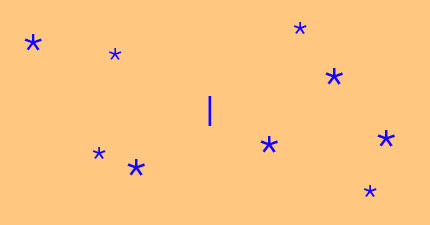In my article about the Aries Point, we went into the four cardinal points along the Aries Point axises and looked at some of the famous people with Suns equal to the AP.
What we found was interesting—those with Sun either conjunct or in opposition to the AP (at 0º Aries or 0º Libra) worked more closely either with or against ideology. They tended to do this work through language, whether that language was the writing of texts or scores. In contrast, the people with Suns square the AP (0ºCancer or 0º Capricorn) were more engaged in performance, whether they did that work as an artist, a musician, an actor, or as a playwright. Their work tended to come across through image.
However, images are often expressed through words and vice versa. The distinction between the two axis is that, while the Aries-Libra, or equinox, axis seems to promote rhetorical argument (at least based on my observational data), the line between Cancer-Capricorn, or solstice, seems to promote symbolic propaganda. Therefore, I’m going to be considering the equinox line between 0º Aries and Libra as the axis of rhetoric and the solstice line between 0º Cancer and Capricorn as the axis of propaganda, while keeping in mind that Aries-Libra may tend to work more with words while Cancer-Capricorn may tend to work more visually.
What antiscia and contra-antiscia have to do with the AP
Basically, any two points that send antiscion or contra-antiscion have a midpoint which is equal to the AP. What this means is that, when you look for antiscia or contra-antiscia aspects, you’re looking for planets or points that are at an equal distance along the ecliptic to the solstice or equinox points.
For example, if your Mercury is at exactly 18º Pisces and your Moon is at exactly 12º Aries, then they could send contra-antiscion since Aries and Pisces send contra-antiscion and 18 plus 12 is exactly 30. If you calculate the midpoint of Mercury and Moon, you would find that it is conjunct the AP. Mercury is exactly 12º away from 0º Aries while Moon is also exactly 12º away from 0º Aries.
Thus, antiscia and contra-antiscia aspects are a sign-to-sign relationship that signals a midpoint which is equal to the AP. While midpoints are generally considered a modern technique, it looks like older astrologers were dealing with midpoints to the AP when calculating antiscia and contra-antiscia.
This is also why, when you calculate antiscia and contra-antiscia aspects, you shouldn’t use an orb more than one degree. Since the AP is a point and not a planet, it has no orb.
Antiscia, contra-antiscia, equinox, and solstice
In my article about antiscia and contra-antiscia, we found that antiscia relationships are considered to be operating at an equal level since those signs are literally at an equal declination. In contrast, contra-antiscia relationships show two points which are in unequal positions. In contra-antiscia relationships, the sign with the longer duration of daylight commands the sign with the shorter duration of daylight.
The interesting thing about antiscia and contra-antiscia relationships is that, while antiscion are sent across the solstice line, contra-antiscion are sent across the equinox line. Since all points equal to the AP have to do with representation, the equinox line has more to do with rhetorical representation while the solstice line has more to do with propagandistic representation.
This is interesting because Greek astrologers, such as Paulus Alexandrinus, wrote that contra-antiscia aspects “hear each other” and that these aspects are especially well received for fugitives, those in exile, and those who have gone abroad. In other words, contra-antiscia aspects are associated with geographical distance and people who are not in the same place. Antiscia aspects, on the other hand, are said to be confronting and planets sending antiscion are able to see each other. Assumingly, this is because they’re happening in the same place.
However, what did Alexandrinus mean when he wrote that contra-antiscia aspects can “hear” each other while antiscia aspects can “see” each other?
Rhetoric versus propaganda
While the word rhetoric is based on the Greek verb rhetor, which means to speak, the word propagate is based on the Latin root propagare, which means to breed or increase in number. In Aristotle’s time, speaking was considered a more pure form of thought than writing or recording since it was considered to be older. In this context, rhetoric is connected to creativity through abstract idea making—to make something out of nothing. Propaganda, however, is based on a word that is connected to reproduction. It is connected to creativity through reproduction—to make something out of something. Also, while the type of abstract creative activity associated with speaking is mostly immaterial and invisible, the type of physical creative activity associated with reproduction is biological and visible. Thus, rhetoric has a lot to do with invisible, immaterial representation and propaganda with visible, material representation.
Since antiscia aspects are based on an equal relationship and are drawn across the solstice line of propaganda, it appears that the confronting signs are able to see one another not only because they’re on equal footing so to speak but also because they produce material consequences. They work on the physical level, on bodies, the earth, and vegetation. Antiscia aspects are able to be seen.
Contra-antiscia aspects are based on a hierarchical relationship and are able to hear each other. They are drawn across the equinox line and have more to do with invisible and immaterial representation. They’re associated with a patriarchal type of creativity, which does not produce bodies or vegetation or stuff but abstractly and through idea making. If the Aries Point is sometimes called the genius point, then contra-antiscion sending points are associated with the machismo type of genius that generates (“genius” and “generate” both share the Latin root gen-) ideas and not bodies. These acts of genus can create concepts which are intentionally hard to grasp, since their non-physicality is what gives them authority. Furthermore, genus that is performed immaterially is always due to the presence of two planets or points that are in a hierarchical, commanding and obeying, relationship.
There is also a gendered dichotomy inherent in these tropes. Rhetoric is more associated with intellectual banter and debate, and the fears around rhetoric with mental manipulation or academic elitism. Propaganda is more associated with a specific nation or group. Fears around propaganda in the West, which increased during the Cold War, have to do with fearing an increase in population socialist nations. While those engaging in rhetorical debate are thought to be critical and active, those accepting propagandistic messages are stereotyped as unthinking and passive.


